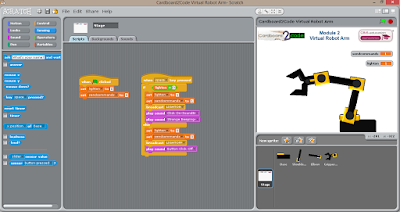Well, the honest answer is I don't I use what others have done before. A good
starting point is this site http://www.wikihow.com/Use-a-USB-Robotic-Arm-with-a-Raspberry-Pi-(Maplin), it gives most (pretty much all) of the answer, including where to get the pyusb library need; setting it up (be careful don't use the zip file but the tar.gz version - you might need to scroll down the screen to do this) and an example. A second source that was very useful was http://notbrainsurgery.livejournal.com/38622.html?view=93150#t93150 which contains an explanation of the 'triples' (for example [32,0,0]) used to select which part of the arm moves and what it does (in the example [32,0,0] causes the Robot Elbow to move down).
The code below is largely based on the code in http://www.wikihow.com/Use-a-USB-Robotic-Arm-with-a-Raspberry-Pi-(Maplin) the only real changes are named procedures (such as ElbowUp) in place of the slightly less easy to understand lines such as MoveArm(Duration,[4,0,0]) #wrist up . The only other changes was a procedure that changes what the light does (0 - light off; 1 - light on; 3 - pulses by a number of times).
import usb.core, usb.util, time
RoboArm = usb.core.find(idVendor=0x1267, idProduct=0x000)
if RoboArm is None:
raise ValueError("Arm not found")
Duration=1
#Define a procedure to execute each movement
def MoveArm(Duration, ArmCmd):
#Start the movement
RoboArm.ctrl_transfer(0x40,6,0x100,0,ArmCmd,3)
#Stop the movement after waiting a specified duration
time.sleep(Duration)
ArmCmd=[0,0,0]
RoboArm.ctrl_transfer(0x40,6,0x100,0,ArmCmd,3)
def RotateBaseClockwise(Duration):
MoveArm(Duration,[0,1,0]) #Rotate base clockwise
def RotateBaseAntiClockwise(Duration):
MoveArm(Duration,[0,2,0]) #Rotate base clockwise
def ElbowUp(Duration):
MoveArm(Duration,[16,0,0]) #Elbow up 0x10
def ElbowDown(Duration):
MoveArm(Duration,[32,0,0]) #Elbow down 0x20
def WristUp(Duration):
MoveArm(Duration,[4,0,0]) #wrist up 0x04
def WristDown(Duration):
MoveArm(Duration,[8,0,0]) #wrist down 0x08
def CloseGripper(Duration):
MoveArm(Duration,[1,0,0]) #close gripper 0x01
def OpenGripper(Duration):
MoveArm(Duration,[2,0,0]) #open gripper 0x02
def ShoulderUp(Duration):
MoveArm(Duration,[64,0,0]) #shoulder up 0x40
def ShoulderDown(Duration):
MoveArm(Duration,[128,0,0]) #shoulder down 0x80
def GripLight(Action, Duration):
if (Action==1):
MoveArm(Duration,[0,0,1]) #light on
if (Action==0):
MoveArm(Duration,[0,0,0]) #light off
if (Action==3):
for x in range(Duration):
MoveArm(1,[0,0,1]) #light on
MoveArm(1,[0,0,0]) #light off
WristUp(0.5)
OpenGripper(0.5)
RotateBaseClockwise(2)
RotateBaseAntiClockwise(2)
ElbowUp(1)
ElbowDown(1)
WristDown(0.5)
CloseGripper(0.5)
ShoulderUp(3)
ShoulderDown(1)
GripLight(3,3)
See it action in the video below.
All opinions in this blog are the Author's and should not in any way be seen as reflecting the views of any organisation the Author has any association with.




